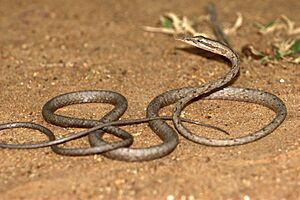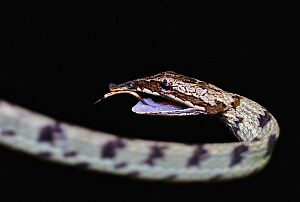Ahaetulla pulverulenta facts for kids
Quick facts for kids Ahaetulla pulverulenta |
|
|---|---|
 |
|
| Conservation status | |
| Scientific classification | |
| Genus: |
Ahaetulla
|
| Species: |
pulverulenta
|
| Synonyms | |
|
Dryophis pulverulentus |
|
The Brown-speckled whipsnake, also known as the brown vine snake (scientific name: Ahaetulla pulverulenta), is a type of snake. It's a species of colubrid snake, which is a very large family of snakes. This particular snake is special because it is endemic to Sri Lanka. This means it is found naturally only in Sri Lanka and nowhere else in the world.
What's in a Name?
In Sri Lanka, people call this snake henakadaya in the Sinhalese language. Interestingly, this old name actually helped create the name for the famous anaconda snake!
The scientific name for this snake is pulverulenta. This word comes from Latin. It means "dusty" or "ashy," which is a good way to describe the snake's grayish-brown color.
Where It Lives
This snake is found only in Sri Lanka. There used to be some thought that it lived in the Western Ghats of India too. However, scientists now believe those snakes are a different species called Ahaetulla sahyadrensis.
The brown vine snake lives in forests. It is fully arboreal, which means it spends all its time living in trees and bushes.
What It Looks Like
The brown vine snake is usually grayish-brown. It has darker, almost black, spots on its back. Its snout, or nose, is pointed. It even has a small, soft part at the very tip of its snout.
On top of its head, it has a dark brown, diamond-shaped spot. There is also a brown stripe on each side of its head. This stripe goes right through its eye.
How It Behaves
This snake is a predator. It likes to eat lizards and other small creatures without backbones, like insects.
The brown vine snake is ovoviviparous. This is a special way of having babies. Instead of laying eggs, the mother snake keeps the eggs inside her body until they hatch. Then, she gives birth to live baby snakes. A mother brown vine snake usually gives birth to between 5 and 15 young snakes at a time.
Gallery








